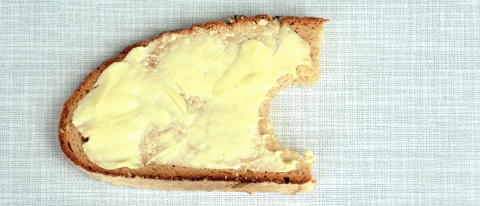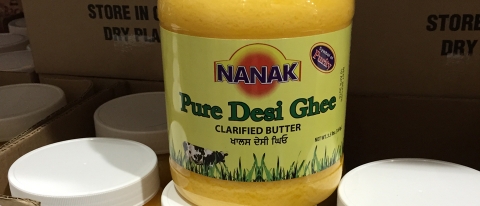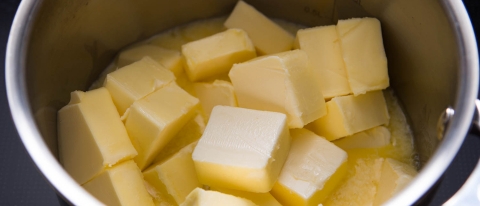My “bread and butter” is demystifying science. Often that takes me down a slippery slope, slaloming between gates of “ifs,” “buts” and “maybes,” never quite getting to that definitive finish line. I’m talking about issues such as endocrine disruptors, fluoridation, agricultural chemicals, dietary supplements, weight loss schemes and viral transmission. Sometimes, however, I feel quite confident in providing an answer to questions that are raised. And this week I have been inundated with queries about the safety of our butter supply. Why? Because some consumers have apparently observed that butter “doesn’t melt the way it used to.” In this instance I’m willing to state confidently, that this observation, which may or may not be valid, has nothing to do with any health consequences that may be attributed to the consumption of butter.
A number of media reports have proposed that the supposed change in the melting qualities of butter may be traced to the addition of palm oil to the feed of cows. In many minds this has raised questions about a possible impact on health of consuming this “unnatural” butter, adulterated with an oil that has often been vilified on account of its high saturated fat content. Is this not just another example of an immoral industry colluding with an uncaring government to market a product that may compromise the health of the public, some have wondered?
Anybody who thinks that their health is going to be affected by a change in the hardness of their butter is in need of some hard facts. Butter is hardly a “health food,” something we may suspect because it tastes so good. It is roughly 80% fat, half of which is of the saturated variety, the kind that has been linked with cardiovascular disease. While the evidence against saturated fats may not be as strong as once thought, it is still prudent to limit their intake. Feeding palm oil, usually 1-2% of the cow’s diet, is perfectly legal, and does increase the fat content of the milk which can be to the farmer’s advantage because the pricing of the milk is based on its butterfat content. But the effect this has on the nutritional aspects of butter is insignificant.
The fats in palm oil are referred to as “by-pass fats” because they bypass digestion in the rumen and end up being absorbed into the bloodstream and thence into the milk. The main saturated fat in palm oil is palmitic acid, which is also the main saturated fat in butter! A small change in the amount of palmitic acid in butter due to palm oil in the feed is inconsequential in terms of health, but could conceivably alter the rheology of butter, making it harder to spread, tearing the bread. Annoying. I would suggest, though, that if you are experiencing this, you are eating the wrong kind of bread, the soft, white variety. Spreading hard butter will not be destructive if you are applying it to high quality sourdough slices.
It is well known that the fat composition of butter is variable, affected by factors such as the breed and age of the cow (at least six breeds are common in Canada), the time of the year, (temperature affects fat and protein content of milk), whether the cow is grain or grass fed, and the kinds of bacteria that compose the animal’s microbiome. All of these can have an effect on the ratio of polyunsaturated, monounsaturated and saturated fats. But in context of the overall diet, this is irrelevant. A 2000 calorie daily diet should have no more than roughly 200 calories of saturated fat which translates to 22 grams. A tablespoon of butter has about 7 grams, of which a third is palmitic acid. Is a fraction of a gram change in the palmitic acid content in a spoonful of butter that may be due to palm oil going to have an effect on blood cholesterol? Nope. And a spoonful of butter a day should satisfy the taste buds. Furthermore, there is no evidence I can find showing that the amount of palmitic acid in butter is actually altered by the addition of palm oil to the cow’s feed. In any case, it is the total amount of butter in the diet matters, not whether that butter has a touch more or less of any specific fatty acid.
But if the change due to the addition of palm oil is so small, how can it affect the texture of the butter? I’m not convinced it does. This would have to be studied, comparing butter from cows that have consumed palm oil to butter from cows on other feeds. Anecdotal observations do not science make. However, if you are looking for a reason to oppose the addition of palm oil to dairy cow feed, there is a legitimate one. The increase in palm tree plantations to meet the global demand for the oil squeezed from the palm fruit has resulted in massive deforestation, often through setting fire to forests. The carbon dioxide released contributes significantly to greenhouse gas emissions and the loss of tropical forests has left animals such as orangutans without a habitat. A tragic consequence.
Even if there is some truth to recently produced butter being harder, whatever the reason may be, the problem is not an earth-shaking one. This is mostly a concern when it comes to baking with butter where softness does make a difference. A softer texture allows for better mixing of ingredients and also traps air that is released during baking leading to a fluffier texture of baked goods. If you find yourself confronting the problem of hard butter, there is an easy solution. Heat a cup of water in the microwave for two minutes, take it out, put in butter cut into small cubes and quickly close the door. Do not turn on the microwave oven! Leave for about ten minutes. It is the residual steam that twill soften the butter. Heating butter directly in a microwave is not a good idea. It will not melt evenly and you will get a partial goo.
No, with these arguments I’m not trying to butter up the dairy industry. I really do not care about its profits. But I do care about good science. And the science suggests that while the total amount of butter consumed can affect health, whether it contains a touch more or less palmitic acid has no relevance. A more legitimate concern is that butter consumption has gone up by some 12% because of COVID and home baking. That could have a health consequence! It is, however, hard to get people to examine issues such as hard butter scientifically. They are just too ready to buy emotionally into “Buttergate.” Seems like asking for critical thinking is too much. Akin to wanting our bread buttered on both sides, some might say.






